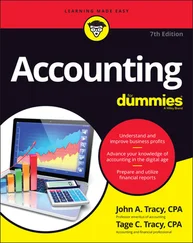Kenneth W. Boyd - Cost Accounting For Dummies
Здесь есть возможность читать онлайн «Kenneth W. Boyd - Cost Accounting For Dummies» — ознакомительный отрывок электронной книги совершенно бесплатно, а после прочтения отрывка купить полную версию. В некоторых случаях можно слушать аудио, скачать через торрент в формате fb2 и присутствует краткое содержание. Жанр: unrecognised, на английском языке. Описание произведения, (предисловие) а так же отзывы посетителей доступны на портале библиотеки ЛибКат.
- Название:Cost Accounting For Dummies
- Автор:
- Жанр:
- Год:неизвестен
- ISBN:нет данных
- Рейтинг книги:4 / 5. Голосов: 1
-
Избранное:Добавить в избранное
- Отзывы:
-
Ваша оценка:
- 80
- 1
- 2
- 3
- 4
- 5
Cost Accounting For Dummies: краткое содержание, описание и аннотация
Предлагаем к чтению аннотацию, описание, краткое содержание или предисловие (зависит от того, что написал сам автор книги «Cost Accounting For Dummies»). Если вы не нашли необходимую информацию о книге — напишите в комментариях, мы постараемся отыскать её.
Cost Accounting For Dummies
Cost Accounting For Dummies
Cost Accounting For Dummies — читать онлайн ознакомительный отрывок
Ниже представлен текст книги, разбитый по страницам. Система сохранения места последней прочитанной страницы, позволяет с удобством читать онлайн бесплатно книгу «Cost Accounting For Dummies», без необходимости каждый раз заново искать на чём Вы остановились. Поставьте закладку, и сможете в любой момент перейти на страницу, на которой закончили чтение.
Интервал:
Закладка:
Other costs are expensed as soon as they are incurred. A good example is marketing costs. Marketing costs are immediately expensed, because it’s difficult to know if and when the costs generated a sale.
If you run a million-dollar ad during the Super Bowl for running shoes, it’s not possible to know how many shoes were sold as a result of running the ad. So you expense it sooner than later. This is the principle of conservatism, which is explained in the next section.
Following the Rules of the Cost Accounting Road
Accountants are big on rules and guidelines. When you have to make a decision as an accountant, you first check for rules and guidelines. Some rules are regulations or laws. This section talks about some critical guidelines you should use in accounting.
Understanding generally accepted accounting principles (GAAP)
Generally accepted accounting principles (GAAP) refer to the rules that accountants must follow when preparing financial statements. The Financial Accounting Standards Board (FASB) is the industry organization that issues GAAP requirements.
The accounting industry’s goal is to generate financial statements that are easier to understand. If every business follows GAAP requirements, the financial statements are comparable between companies. The focus of GAAP is on financial statement users.
Considering the needs of stakeholders
You have a number of stakeholders who need timely and accurate financial statements, including these two groups:
Creditors: If you take out a business loan, your banker will need to see your firm’s financial statements. Your financial performance determines whether you can make principal and interest payments on your loan.
Investors: An investor can profit from selling an investment for a profit, or by receiving a share of a company’s earnings as a dividend. Your investors want to know if your firm is profitable, and if sales are growing over time.
To apply GAAP standards, you need to know the basics. Remember that the goal of using GAAP is to create financial statements that are clear and consistent, so that stakeholders understand company results.
Mulling over consistency
GAAP allows financial statements readers to make “apples to apples” comparisons. A good example is accounting for fixed assets. Generally speaking, fixed assets must be valued at historical cost, meaning the amount paid for the asset. The cost of the asset includes acquisition cost (the check you write for the asset), plus shipping and other costs required to prepare the asset for use.
Say, for example, that two trucking companies each list ten trucks as fixed assets in the balance sheet, and that all the trucks are the same size. If both firms comply with GAAP, the trucks are valued at historical cost less accumulated depreciation.
OK, now assume that company A’s trucks are listed in the balance sheet at $100,000, while B’s trucks have a value of $200,000. What does this data tell you? On average, A’s trucks are worth less than B’s trucks, and that also means that A’s trucks are older and must be replaced sooner.
Company A will have to invest in new trucks before company B. If you were considering investing in either company, that difference would impact your investment decision. A is going to have to spend money on trucks sooner than B, and that leaves less money for other needs.
 If you don’t comply with GAAP accounting now, you should change your accounting as soon as possible. The longer you wait to change, the more difficult it is to convert the accounting records to GAAP. Sure, software packages can do some of the work automatically, but you’ll probably need a CPA firm to clean up the books.
If you don’t comply with GAAP accounting now, you should change your accounting as soon as possible. The longer you wait to change, the more difficult it is to convert the accounting records to GAAP. Sure, software packages can do some of the work automatically, but you’ll probably need a CPA firm to clean up the books.
Deciding on accrual basis or cash basis
The cash basis of accounting recognizes revenue when cash is received and posts expenses when they are paid in cash. This method means that you post your accounting activity based on when cash moves in or out of your business. It’s accounting by “using your checkbook.”
Recognizing revenue or expenses refers to the timing of when you post the amounts to your accounting records.
Installing the cash basis
There’s a problem with the cash basis of accounting — it doesn’t follow the matching principle. This principle requires accountants post revenue when it’s earned and expenses when they are incurred.
The matching principle is a two-step process. Your first step is to determine when revenue is earned. You earn revenue when you deliver your product (as explained earlier), or complete a service you perform for a customer. You may receive payment in advance of the delivery, or a few weeks after the delivery. When you earn, the revenue may be different from when you receive the cash payment.
For a retailer, revenue is earned when the customer walks out of the store with, say, a new baseball glove. If you’re a tax preparer, you earn revenue when you deliver a completed tax return to your client.
After you determine when revenue is earned, you match the revenue to the expenses that are related to the product or service. The retailer would match the inventory cost of the glove with the baseball glove’s revenue. The tax preparer would match the labor cost paid to the staff with the revenue from the tax return.
Because the cash basis doesn’t follow the matching principle, the method is used only by very small businesses. Everyone else uses the accrual method of accounting.
Moving to the accrual method
The accrual method of accounting recognizes revenue when it’s earned and expenses when they are incurred. Accrual accounting is more complicated than the cash basis you just read about (but only a little bit). That’s because your cash may not move in the same period when revenue or expense is recognized.
Say you ship goods to your client in late January. The customer pays for the order in February. You completed everything that the customer required in January, so you should recognize revenue in January. But the cash moves (you get paid) in February.
Accrual accounting requires you to make an entry to accounts receivable and to sales revenue in January. The entry shows that you earned the revenue, even though you haven’t been paid yet. Accounts receivable means that you are owed money for a sale that was posted to revenue in January. When the cash is received in February, you reduce accounts receivable and increase cash.
Assume an employee works in your store during the last week of May. Your next payroll is paid in the first week of June. Your store has sales in May. You should include the salary expense for the employee’s work during May with the May revenue. That’s how the matching principle works. The process matches the effort (costs) with the reward (revenue). However, the cash doesn’t move until June.
Using accrual accounting, you make an entry to accounts payable and salary expense in May. Accounts payable represents an amount you owe as a business expense. So you post the salary expense in May. When you pay the employee in June, you reduce accounts payable and you reduce cash.
Finishing with conservatism
The principle of conservatism relates to decisions you make as an accountant (or as a business owner doing some accounting). By conservative, accountants mean the less-attractive decision. Your goal is to avoid creating accounting records that are overly optimistic.
Читать дальшеИнтервал:
Закладка:
Похожие книги на «Cost Accounting For Dummies»
Представляем Вашему вниманию похожие книги на «Cost Accounting For Dummies» списком для выбора. Мы отобрали схожую по названию и смыслу литературу в надежде предоставить читателям больше вариантов отыскать новые, интересные, ещё непрочитанные произведения.
Обсуждение, отзывы о книге «Cost Accounting For Dummies» и просто собственные мнения читателей. Оставьте ваши комментарии, напишите, что Вы думаете о произведении, его смысле или главных героях. Укажите что конкретно понравилось, а что нет, и почему Вы так считаете.












